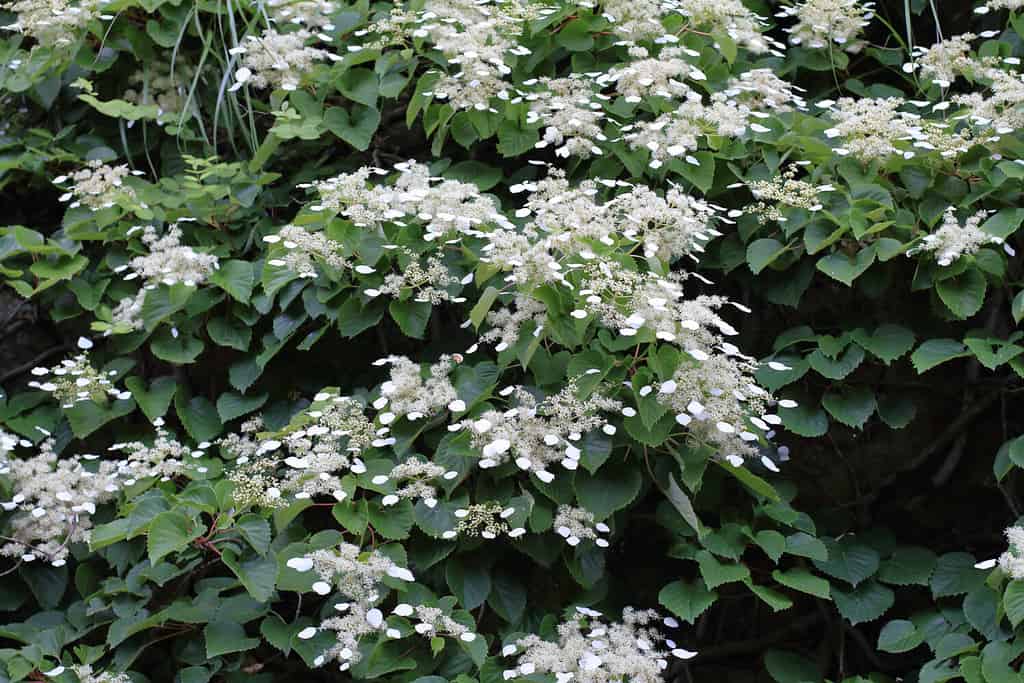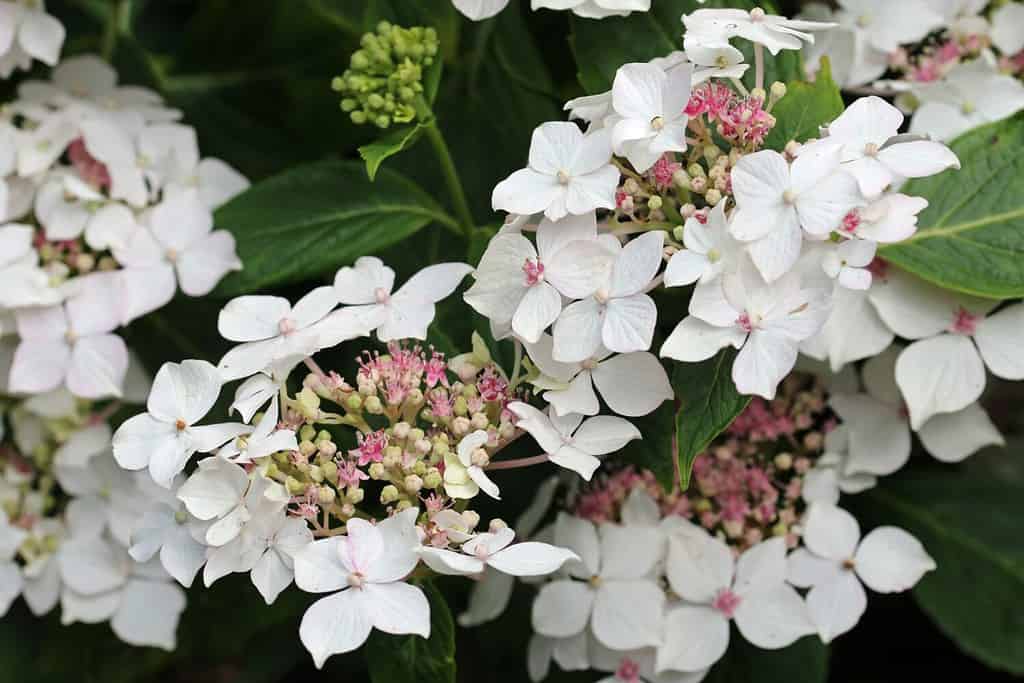Winterizing Hydrangeas: How to Care for Hydrangeas in Winter
Winter’s icy grip may have arrived, but that doesn’t mean your beloved hydrangeas have to suffer. With a bit of care and attention, you can ensure that these beautiful blooms make it through the cold season unscathed. In this guide, we’ll walk you through the essential steps to winterize your hydrangeas.
What are Hydrangeas?
With their gorgeous blossoms and lush foliage, hydrangeas are a fascinating group of flowering shrubs from the Hydrangeaceae family, have mesmerized garden aficionados all over the world. Hydrangeas are native to several regions of Asia and the Americas, and they have a long botanical history. From China and Japan to North and South America, they may be found there.
Distinctive Appearance
Hydrangeas are easily recognized by their large, showy flower heads, which are often arranged in spherical clusters. These blooms consist of smaller, fertile flowers nestled within a ring of petal-like sepals, creating an intricate and captivating appearance. The size and color of hydrangea flowers can vary widely depending on the species and variety. They can range from delicate lacecap blooms to massive, globe-like mopheads. Moreover, the color of hydrangea flowers is influenced by soil pH, with acidic soils producing blue hues and alkaline soils yielding pink or purple shades.
Popularity as Decorative Plants
Hydrangeas have gained immense popularity as decorative plants for several reasons. Their captivating blooms make them a sought-after choice for gardens, parks, and floral arrangements. The appeal of hydrangeas lies in their versatility, as they can be used to create various landscape designs, from formal gardens to casual cottage-style landscapes.

©ziggy_mars/Shutterstock.com
What is Winterizing?
Winterizing plants is a crucial practice in gardening and horticulture. It involves a set of proactive measures aimed at safeguarding plants from the potentially damaging effects of cold temperatures, frost, snow, and winter winds. This process is essential for ensuring the survival and health of many plant species during the harsh winter months.
Why Winterizing Is Important
Winter is a challenging season for most plants, as they undergo a period of dormancy. During dormancy, a plant’s metabolic processes slow down, making them more susceptible to cold-related stressors. Here are some reasons why winterizing is vital:
Protection from Cold TemperaturesCold temperatures can harm a plant’s sensitive tissues, causing damage to leaves, stems, and even roots. Winterizing helps provide a protective shield against these harsh conditions.
Preventing Winter DesiccationDesiccation, a condition that occurs when plants lose water via their leaves and stems, can still occur in hydrangeas during the winter. In areas with windy winters, this may be especially problematic. Your hydrangeas will stay adequately wet and avoid desiccation if you wrap or mulch them.
Preserving Flower BudsMany plants form flower buds in the growing season, which will bloom the following spring. These buds are vulnerable to winter damage. Effective winterization safeguards these precious buds, ensuring a profusion of beautiful blooms in the upcoming season.
Winterizing plants is a proactive and essential practice for gardeners and horticulturists. By understanding the specific needs of each plant species and implementing appropriate winterization methods, you can help your plants endure the challenges posed by winter.
Why Do Hydrangeas Need to Be Winterized?
As the days grow shorter and temperatures plummet, it’s easy to forget about your garden, especially your beloved hydrangea plants. However, neglecting these beautiful shrubs during the winter months can lead to detrimental consequences for their growth and bloom come spring.
Understanding Hydrangeas
Before we jump into the necessity of winterizing hydrangeas, let’s take a moment to understand these versatile flowering shrubs. Hydrangeas are popular for their large, vibrant blooms that can range from shades of pink, blue, purple, and white, depending on the variety and soil pH. These deciduous plants come in different species, with the most common ones being the mophead, lacecap, and panicle hydrangeas.
The Importance of Winterization
Protection from Cold TemperaturesHydrangeas are not particularly fond of frigid winter conditions. Freezing temperatures can lead to damage or even kill off unprotected branches and buds. By winterizing your hydrangeas, you provide them with a shield against the cold, ensuring their survival.
Preventing Winter DesiccationDuring winter, hydrangeas can still lose water through their leaves and stems, a phenomenon known as desiccation. This can be particularly problematic in regions with windy winters. Wrapping or mulching your hydrangeas helps maintain adequate moisture levels and prevents desiccation.
Preserving Flower BudsMany hydrangea varieties produce flower buds in the summer, which will bloom the following year. These buds are delicate and susceptible to winter damage. Proper winterization safeguards these precious buds, ensuring a stunning floral display in the upcoming spring and summer.
Simply put, winterizing your hydrangeas is crucial for the general health and vitality of these gorgeous bushes and goes beyond cosmetic considerations. You can make sure that your hydrangeas will grow and produce a lot of lovely blooms when spring arrives by taking the required measures, such as trimming, mulching, and guarding from cold weather and desiccation.
Can Hydrangeas Survive Cold Temperatures?
Although hydrangeas are well known for their beautiful blossoms and lush foliage, can these well-loved plants withstand the cold? Let’s examine which hydrangea kinds thrive in colder locations and examine whether or not hydrangeas can withstand cold weather.
Hydrangeas and Cold Tolerance
Hydrangeas are generally hardy plants, capable of thriving in a range of climates. However, their cold tolerance varies depending on the species and varieties. Understanding this variability is essential for successful cultivation in regions prone to colder winters.
Cold Tolerance by Species
Different hydrangea species exhibit varying levels of cold tolerance:
- Paniculata Hydrangeas (Hydrangea paniculata): These are among the most cold-hardy hydrangeas. Varieties like ‘Limelight’ and ‘PeeGee’ can withstand temperatures as low as USDA hardiness zone 3, which includes areas with very cold winters.
- Smooth Hydrangeas (Hydrangea arborescens): Varieties like ‘Annabelle’ fall into this category and are known for their cold resistance. They can thrive in USDA zones 4 and higher, making them suitable for many temperate regions.
- Oakleaf Hydrangeas (Hydrangea quercifolia): Oakleaf hydrangeas are hardy to USDA zones 5 through 9 and can tolerate moderately cold winters. Their distinctive foliage and cone-shaped blooms make them a valuable addition to gardens in these zones.
- Mophead and Lacecap Hydrangeas (Hydrangea macrophylla): These hydrangeas are less cold-tolerant and typically thrive in USDA zones 6 to 9. In colder regions, they may require additional winter protection to survive.
With this in mind, let’s look into how exactly you can start winterizing your hydrangeas.

©JohnatAPW/Shutterstock.com
Winterizing Hydrangeas: Tips and Tricks for Protecting Your Plants
1. Pruning
Pruning is an essential step in preparing your hydrangeas for winter. However, it requires careful consideration, as different hydrangea varieties have varying bloom habits.
For Hydrangeas That Bloom on New Wood (e.g., Panicle Hydrangeas):In late fall, prune your hydrangeas to remove any dead or weak branches and spent flowers. Trim back the stems to a manageable height, leaving about 12-18 inches of growth. This will encourage new growth in the spring and prevent your shrub from becoming too tall and leggy.
For Hydrangeas That Bloom on Old Wood (e.g., Mophead and Lacecap Hydrangeas):For these varieties, it’s crucial to avoid heavy pruning in the fall, as this can remove potential flower buds. Instead, wait until after they bloom in the summer to do any significant pruning. You can still remove dead or weak branches and faded blooms in the fall, but be cautious not to cut into the main stems where buds may form.
2. Mulching
Mulching is an effective way to insulate the soil around your hydrangeas, keeping it at a more stable temperature and protecting the roots from freezing.
In late fall, apply a layer of mulch around the base of your hydrangea plants. A two to three inch thick layer of organic mulch, such as wood chips, straw, or shredded leaves, works well. Ensure that the mulch covers the root zone of the plant but does not touch the stems directly. Mulch will help maintain soil moisture and temperature, providing a cozy environment for the roots during the winter.
3. Protecting the Crown
In regions with harsh winters, it’s a good idea to provide extra protection to the base, or crown, of your hydrangea plants. This step is particularly important if you have young or newly planted hydrangeas.
Wrap burlap around the hydrangea’s crown, creating a protective barrier. Be sure to secure the burlap with twine or stakes to prevent it from blowing away in strong winds. The burlap will shield the crown from extreme cold and wind, reducing the risk of damage.
4. Watering
Proper watering is essential for the health of your hydrangeas during the winter months. Hydrangeas still need moisture even in dormancy, but overwatering can lead to root rot. Here’s how to strike the right balance:
Continue to water your hydrangeas until the ground freezes. Adequate moisture is crucial for winter survival. However, once the ground is frozen, you can reduce watering to a minimum, as the plant’s water uptake decreases significantly during dormancy.
5. Location Matters
Choosing the right location for your hydrangea plants can make a significant difference in their winter survival. If possible, plant them in a spot that offers some protection from strong winter winds.
A natural windbreak, such as a fence or other taller plants, can help shield your hydrangeas from the harshest winter gusts. This simple step can go a long way in preventing winter desiccation.
6. Snow Accumulation
In regions with heavy snowfall, keep an eye on your hydrangeas throughout the winter. Snow accumulation can weigh down the branches, potentially causing them to break.
Gently brush off excess snow with a broom or your hand to relieve the weight on the branches. Be cautious while doing this, ensuring not to damage the plant in the process. Removing snow from your hydrangeas is especially crucial if your area experiences wet, heavy snowfall.
Winterizing Hydrangeas: It’s Worth It
It’s crucial to winterize your hydrangeas in order to maintain their health and vigor throughout the chilly winter months. You can give your beloved hydrangeas the care they require to flourish year after year by being aware of the particular requirements of your hydrangea variety and using the proper winterization techniques, such as pruning, mulching, protecting the crown, watering, selecting the best location, and dealing with snow accumulation.
By taking these precautions, you can invest in the beauty and durability of your yard by protecting your hydrangeas over the winter. When April arrives and your garden awakens from its winter slumber, you may anticipate a spectacular display of hydrangea blossoms thanks to careful winterization. Give your hydrangeas the care and attention they require as the frigid days get closer in order to ensure their sustained beauty and vibrancy in your garden environment. Happy planting!









